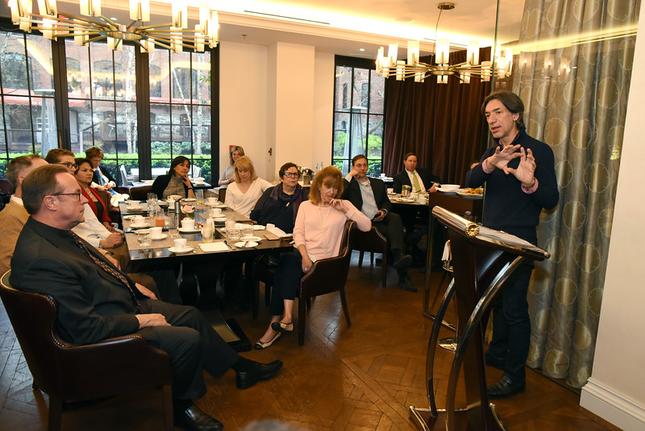Septime: Going Out in Style
By • April 18, 2016 0 809

Septime Webre — casual, blue jeans, pullover and checkered shirt and hair flying — was in his element. He was saying goodbye, sort of, to his last 17 years as artistic director of the Washington Ballet, but also hello “to my next 17 years, by which time I’ll be 70.”
Webre was his own star as the first spring headliner in Georgetown Media Group’s Cultural Leadership Breakfast Series, now at the Cappella hotel. An almost preternatural storyteller, he covered his progress through his years at the Washington Ballet, nurtured for many years by founder Mary Day, and the last days of his tenure (he steps down at the end of June).
“This sort of feels like a victory tour, like the baseball players do,” he said. “It’s so good to see so many supporters here, including my former chairman of our board Kay Kendall and others, and it’s wonderful to talk about the company. I’m really, really proud of what we’ve done here in this city, which, when I got here, didn’t have what you could call a diverse arts community. The city was still a little quiet then, and truth to tell, the food wasn’t much either.”
What he encountered was a company that did traditional programming, notably the yearly “Nutcracker” (which Webre expanded, and made expansive to the point that it included hundreds of young dancers). “I think, initially, we were thinking about new choreographers, new dancers, a new group of more diverse people, young dancers like Brooklyn Mack who grew into their persona and into being able to use all their gifts.”
“I loved Mary Day, she was the founder, she was our visionary person,” he said. “She was elegant in everything she did, she was something else.”
Webre arrived from Cuba with his family, the seventh son in a pretty creative bunch. “On a beach in the Bahamas, two of my brothers and I created an entire Versailles complex on the beach with sand.”
He recounted the phases in his time leading and choreographing for the company. “You start out with Balanchine. And, at that time, all the serious people were like art people: everything abstract, no narrative. But I discovered something about myself. I liked being a storyteller, I like doing the big ballets, new ones.”
To that end, he revolutionized things. He started a series of full-length narrative works that included “The Sun Also Rises,” “The Great Gatsby,” “Alice in Wonderland,” “Sleepy Hollow” — pretty big productions. And, by the way, “The Sun Also Rises” was “basically a great ballet about erectile dysfunction,” he noted.
“To me,” he said, “it was about building a company, young dancers, the school, THEARC [in Anacostia] and so on. And we discovered our niche. The Kennedy Center was bringing in all the great ballet companies, doing the big ballet pieces, and that was fine, but we could do something that identified us as a Washington company. It was a niche for a different kind of creativity. Sure we did some of the classics, but that was never all we did.” He referred to bringing choreographers such as Twyla Tharp and Mark Morris to Washington.
“And I believe in diversity of programming, of artists and dancers,” he said. “I recognize that when people come to a program that they want to be able to see themselves up there.”
As for the future? “I’m ready for the next thing. I want to concentrate on my work as a choreographer, a creator, and move on to work with other people — here, to be sure, but in Australia, in Istanbul, in Europe and other places. I’m looking forward to the next thing. I’m not moving, although my partner and I will be having a place in New York.”
He’s still a Washington guy, and something of treasure here: unique in his style, his outlook, that fizz and energy he brings to every encounter. “No question, I’m a workaholic, that’s where it all comes from.”
He’s Septime Webre, going out in style.
- Septime Webre speaking at the Capella hotel in Georgetown. | Photo by Neshan H. Naltchayan.



